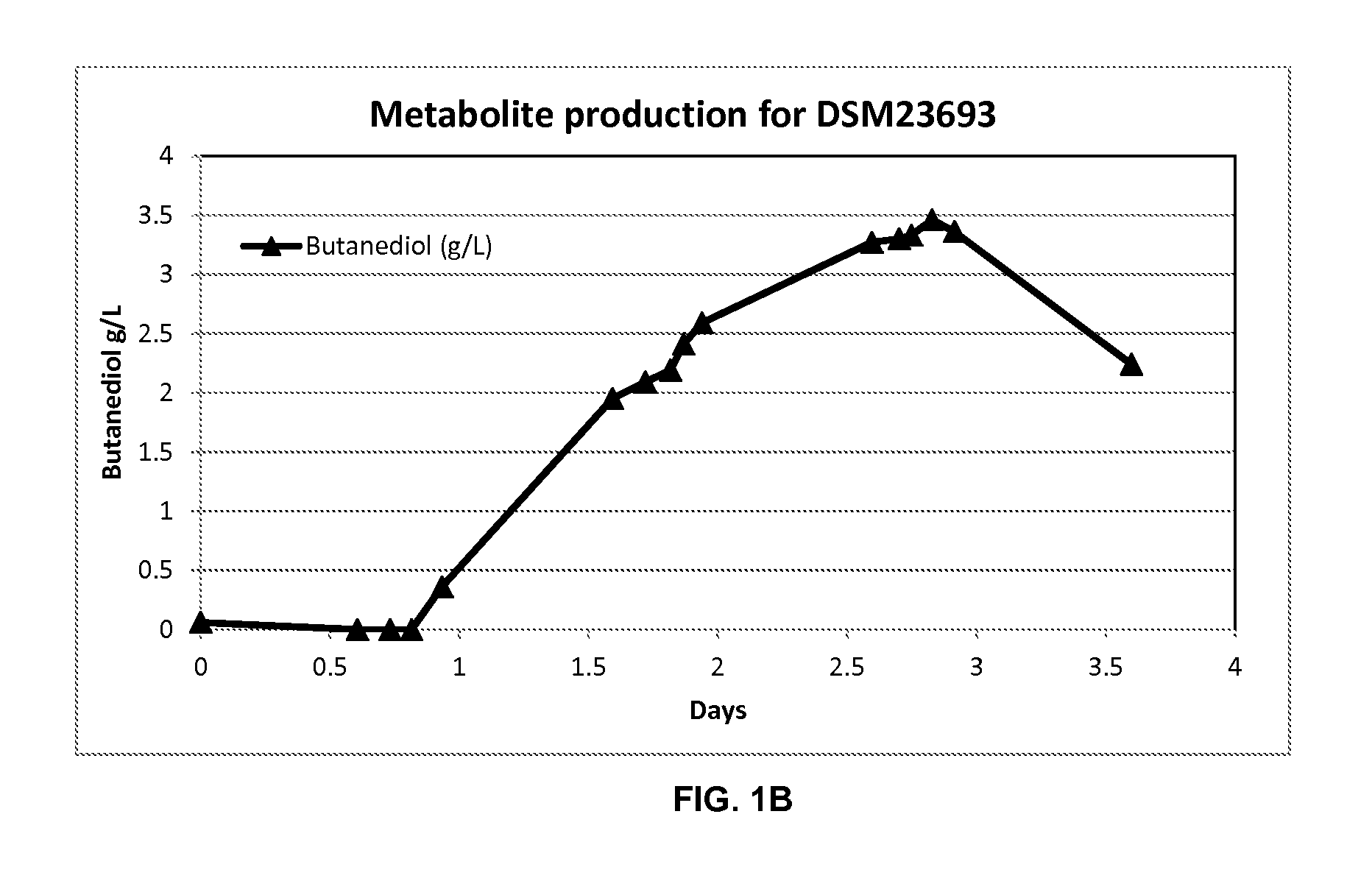Process for producing chemicals using microbial fermentation of substrates comprising carbon monoxide
a technology of carbon monoxide and chemical production, which is applied in the field of microbial fermentation of substrates comprising co, can solve the problems of increasing the cost of industrial plants, releasing co into the atmosphere, and affecting the environmen
- Summary
- Abstract
- Description
- Claims
- Application Information
AI Technical Summary
Benefits of technology
Problems solved by technology
Method used
Image
Examples
example 1
Materials and Methods
[0087]
Solution ANH4Ac3.083gKCl0.15gMgCl2•6H2O0.4gNaCl0.12g(optional)CaCl2•2H2O0.294gDistilled WaterUp to 1LSolution BBiotin20.0mgCalcium D-(*)-50.0mgpantothenateFolic acid20.0mgVitamin B1250.0mgPyridoxine•HCl10.0mgp-Aminobenzoic50.0mgacidThiamine•HCl50.0mgThioctic acid50.0mgRiboflavin50.0mgDistilled waterTo 1LitreNicotinic acid50.0mgSolution Cmmol / LComponentH2OComponentmmol / L H2OFeCl30.1Na2SeO30.01CoCl20.05Na2MoO40.01NiCl20.05ZnCl20.01
Preparation of Cr (II) Solution
[0088]A 1 L three necked flask was fitted with a gas tight inlet and outlet to allow working under inert gas and subsequent transfer of the desired product into a suitable storage flask. The flask was charged with CrCl3.6H20 (40 g, 0.15 mol), zinc granules [20 mesh] (18.3 g, 0.28 mol), mercury (13.55 g, 1 mL, 0.0676 mol) and 500 mL of distilled water. Following flushing with N2 for one hour, the mixture was warmed to about 80° C. to initiate the reaction. Following two hours of stirring under a consta...
example 2
Materials and Methods
Bacterial Strains and Growth Conditions:
[0099]C. autoethanogenum DSM 10061 and C. ljungdahlii DSM 13582 were obtained from DSMZ (Deutsche Sammlung von Mikroorganismen and Zellkulturen GmbH) and C. ragsdalei ATCC-BAA 622™ from ATCC (American Type Culture Collection). All organisms were cultivated anaerobically in modified PETC medium (ATCC medium 1754) at 30° C. (C. ragsdalei) or respectively 37° C. (C. autoethanogenum and C. ljungdahlii).
[0100]The modified PETC medium contained (per L) 1 g NH4Cl, 0.4 g KCl, 0.2 g MgSO4×7 H2O, 0.8 g NaCl, 0.1 g KH2PO4, 20 mg CaCl2×2 H2O, 10 ml trace elements solution (see below), 10 ml Wolfe's vitamin solution (see below), 2 g NaHCO3, and 1 mg resazurin. After the pH was adjusted to 5.6, the medium was boiled, dispensed anaerobically, and autoclaved at 121° C. for 15 min. Steel mill waste gas (composition: 44% CO, 32% N2, 22% CO2, 2% H2) collected from a New Zealand steel site in Glenbrook, NZ or 0.5% (w / v) fructose (with N2 head...
example 3
Materials and Methods
[0105]C. autoethanogenum as deposited at the DSMZ (Deutsche Sammlung von Mikroorganismen and Zellkulturen GmbH) under the accession number DSM23693.
Sampling and Analytical Procedures:
[0106]Media samples were taken from the CSTR reactor at intervals over the course of each fermentation. Each time the media was sampled care was taken to ensure that no gas was allowed to enter into or escape from the reactor.
[0107]HPLC: HPLC System Agilent 1100 Series. Mobile Phase: 0.0025N Sulfuric Acid. Flow and pressure: 0.800 mL / min. Column: Alltech 10A; Catalog #9648, 150×6.5 mm, particle size 5 μm. Temperature of column: 60° C. Detector: Refractive Index. Temperature of detector: 45° C.
[0108]Method for sample preparation: 400 μL of sample and 50 μL of 0.15M ZnSO4 and 50 μL of 0.15M Ba(OH)2 are loaded into an Eppendorf tube. The tubes are centrifuged for 10 min. at 12,000 rpm, 4° C. 200 μL of the supernatant are transferred into an HPLC vial, and 5 μL are injected int...
PUM
| Property | Measurement | Unit |
|---|---|---|
| concentration | aaaaa | aaaaa |
| concentration | aaaaa | aaaaa |
| concentration | aaaaa | aaaaa |
Abstract
Description
Claims
Application Information
 Login to View More
Login to View More - R&D
- Intellectual Property
- Life Sciences
- Materials
- Tech Scout
- Unparalleled Data Quality
- Higher Quality Content
- 60% Fewer Hallucinations
Browse by: Latest US Patents, China's latest patents, Technical Efficacy Thesaurus, Application Domain, Technology Topic, Popular Technical Reports.
© 2025 PatSnap. All rights reserved.Legal|Privacy policy|Modern Slavery Act Transparency Statement|Sitemap|About US| Contact US: help@patsnap.com



